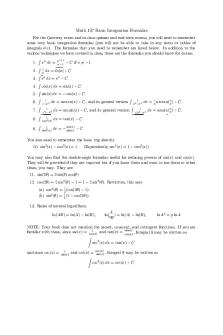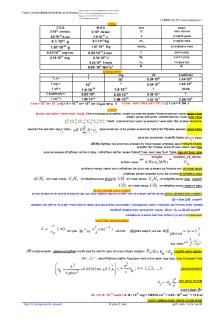Day 1-Accounting Basic Formulas & Definitions PDF

| Title | Day 1-Accounting Basic Formulas & Definitions |
|---|---|
| Author | Anonymous User |
| Course | Financial Accounting |
| Institution | Endicott College |
| Pages | 2 |
| File Size | 87.9 KB |
| File Type | |
| Total Downloads | 40 |
| Total Views | 141 |
Summary
Basic Accounting Formulas...
Description
Accounting)Basics-Formulas)&)Definitions) )
3 Key Financial Statements: 1) BALANCE SHEET Balance Sheet Equation: Assets = Liabilities + Equity Assets • • • •
Cash Accounts Receivable (payment due from customer) Inventory Fixed Assets (laptops, machinery & equip)
= • •
Liabilities Accounts Payable (payment owed to suppliers) Notes/Bonds Payable (loans)
+ • •
Equity Stock Retained Earnings
2) INCOME STATEMENT Income Statement Equations: Service Company: Revenue - Expenses Net Income (Loss)
Manufacturing Company: Revenue - Cost of Goods Sold (COGS) Gross Profit - Operating Expenses Net Income (Loss)
Revenue Calculations: Service Company Revenue = # of Hours Worked for Customer * Hourly Rate (i.e. Revenue for home repair = 5 hours * $10/hour = $50 in Revenue) Manufacturing Company Revenue = Quantity of Product Sold * Price of Product (i.e. Revenue for t-shirts = 100 t-shirts sold * $10/shirt = $1,000 in Revenue) Examples of Operating Expenses: • Salaries Expense • Rent Expense • Telephone/Utilities Expense 3) STATEMENT OF CASH FLOWS Cash Receipts (CASH IN) and Cash Disbursements (CASH OUT) categorized into 3 major activities: 1) Operating 2) Investments 3) Financing
)
Accounting)Basics-Formulas)&)Definitions) ) REVENUE - is the value of what is received for goods sold, services rendered, and other financial sources of revenue, such as rents earned, interest earned, etc. COSTS OF GOODS SOLD - is a measure of the cost of merchandise sold or cost of raw materials and supplies used for producing items for resale GROSS PROFIT - is how much a company earned by buying (or making) and selling merchandise = Revenue minus COGS NET INCOME - is revenue left over after all costs and expenses, including taxes, are paid. OPERATING EXPENSES - are costs involved in operating a business, such as rent, insurance, utilities, and salaries. DEPRECIATION - (also an operating expense) is the systematic write-off of the cost of a tangible asset over its estimated useful life. (such as equipment and machinery). BALANCE SHEET - the financial statement that reports a firm’s financial condition at a specific time and is composed of three major accounts: assets, liabilities, and owner’s equity. THE FUNDAMENTAL ACCOUNTING EQUATION- Assets = Liabilities + Owner’s Equity ASSETS - Economic resources owned by a firm. Items can be tangible or intangible. LIQUIDITY - Ease with which assets can be converted into cash. LIABILITIES - What the business owes to others - its current or long-term debts. ACCOUNTS PAYABLE - Current liabilities a firm owes for merchandise or services purchased on credit. OWNERS’ EQUITY - The amount of the business that belongs to the owners minus any liabilities of the owners (includes Retained Earnings) RETAINED EARNINGS - Accumulated earnings from the firm’s profitable operations that are reinvested in the business. STATEMENT OF CASH FLOWS - Reports cash receipts and cash disbursements related to the three major activities of a firm: 1) Operations 2) Investments 3) Financing LIQUIDITY RATIOS - measure the company’s ability to turn assets into cash to pay its short-term debts, which are expected to be repaid within one year LEVERAGE RATIOS - measure the degree to which a company relies on borrowed funds in its operations. PROFITABILITY RATIOS - measure how effectively a company is using its various resources to achieve profits and are vital measurements of company growth and management performance.
)...
Similar Free PDFs

Basic Definitions and Theories
- 4 Pages

Basic integration formulas
- 1 Pages

Basic Derivative Formulas
- 1 Pages

Day 1 - Day 1
- 2 Pages

Tumws 20VDA-Formulas - Formulas
- 5 Pages

Formulas
- 2 Pages

125001-Formulas - formulas sheet
- 8 Pages

Formulas
- 6 Pages
Popular Institutions
- Tinajero National High School - Annex
- Politeknik Caltex Riau
- Yokohama City University
- SGT University
- University of Al-Qadisiyah
- Divine Word College of Vigan
- Techniek College Rotterdam
- Universidade de Santiago
- Universiti Teknologi MARA Cawangan Johor Kampus Pasir Gudang
- Poltekkes Kemenkes Yogyakarta
- Baguio City National High School
- Colegio san marcos
- preparatoria uno
- Centro de Bachillerato Tecnológico Industrial y de Servicios No. 107
- Dalian Maritime University
- Quang Trung Secondary School
- Colegio Tecnológico en Informática
- Corporación Regional de Educación Superior
- Grupo CEDVA
- Dar Al Uloom University
- Centro de Estudios Preuniversitarios de la Universidad Nacional de Ingeniería
- 上智大学
- Aakash International School, Nuna Majara
- San Felipe Neri Catholic School
- Kang Chiao International School - New Taipei City
- Misamis Occidental National High School
- Institución Educativa Escuela Normal Juan Ladrilleros
- Kolehiyo ng Pantukan
- Batanes State College
- Instituto Continental
- Sekolah Menengah Kejuruan Kesehatan Kaltara (Tarakan)
- Colegio de La Inmaculada Concepcion - Cebu







